The palace of the Ministry of Finance under 6 Szentháromság Square is a unique structure in both its location and architectural solutions. As the restoration of the original facade is now underway, the time is ripe to take a look at the artistic efforts that defined the building.
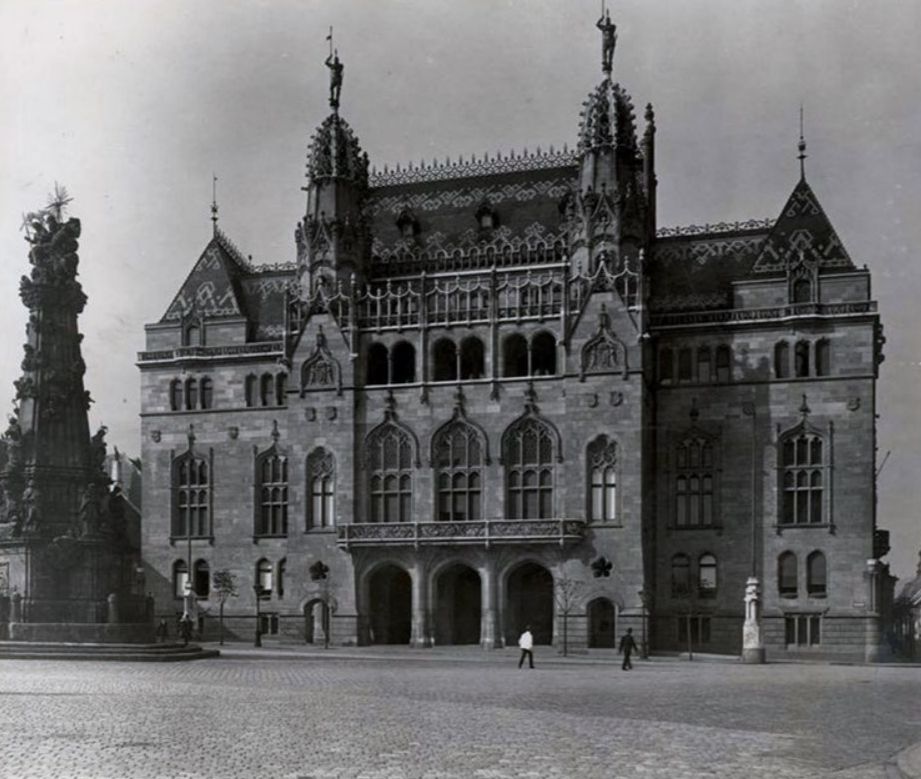
The building of the Royal Hungarian Ministry of Finance (Photo: FSZEK Budapest Collection)
The palace of the Ministry was built between 1901 and 1904 based on plans by the architect Sándor Fellner. The neo-Gothic style of the building was criticised by many at the time, and in an album about the palace published in 1908, Fellner wrote:
"The task at hand was to create a harmonious image on the square... As soon as I considered all factors, the forms of the Gothic period closest to the aesthetic and practical aspects of our day came as a natural solution, as they allow for the creation of monumental effect, and can be modified into a modern a national direction."
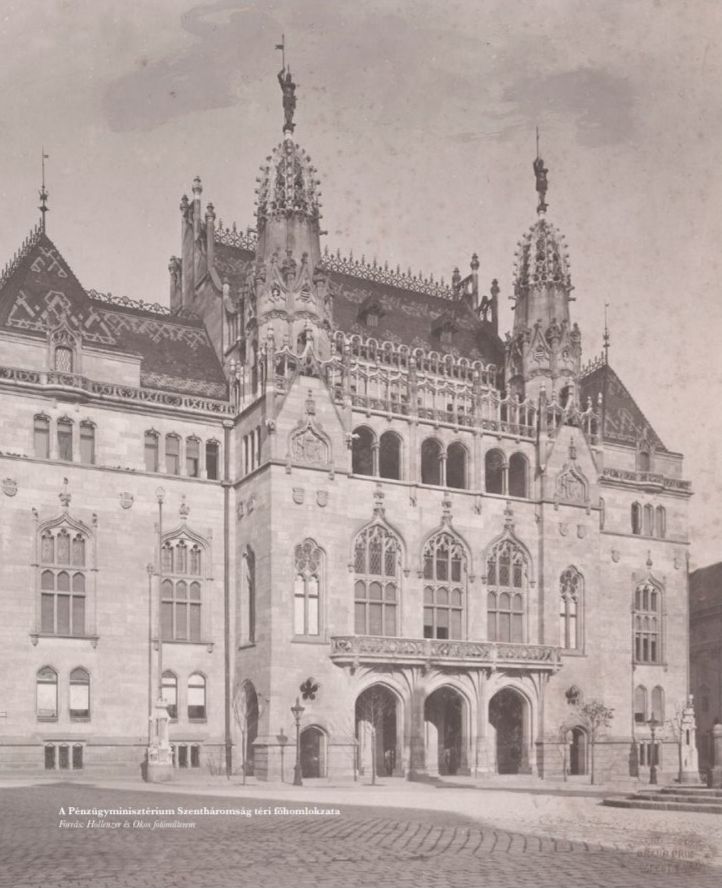
Main facade of the palace on Szentháromság Square (Photo: FSZEK Budapest Collection)
In addition to their common style, other similarities between the Church of Our Lady in Budapest Castle and ministry can be seen. Both were covered with colourful Zsolnay roof tiles to ensure harmony on the square. The tiles also connect these buildings to a third in the Castle District: the Hungarian National Archives. A close examination of the roof reveals a pattern similar to the braided decorative elements of Hungarian clothing.
The contract for the pyrogranite, majolica and terracotta sculptures was signed with the Zsolnay factory on 9 July 1902. The Zsolnay name was almost unavoidable in the period, and the factory in Pécs participated in the construction of several significant buildings in the 19th–20th centuries. Miklós Zsolnay purchased a plot, a clay mine and a brick kiln in Pécs in 1851, his son later took over the business, and created the First Cement, Chamotte, and Refractory Ceramics of Pécs while experimenting with new methods and techniques.
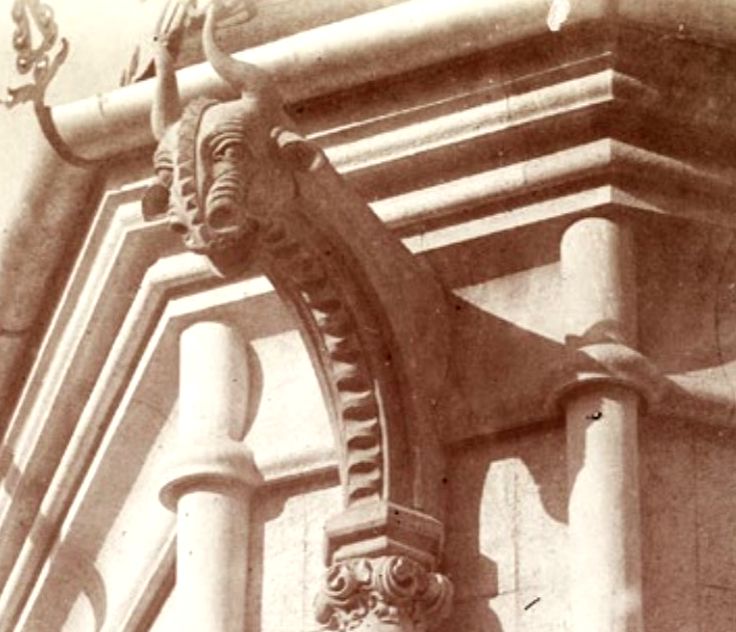
Gargoyle with the bull's head as seen on the Treasure of Nagyszentmiklós, created by the Zsolnay factory on the facade of the Hungarian parliament building (detail) (Source: FSZEK Budapest Collection)
The production of ceramics for architectural use intensified in the 1880s. Pyrogranite, the latest invention of the Zsolnay factory can be seen not only on the Hungarian Houses of Parliament but several other public buildings in Hungary. At the beginning of the 20th century, the Zsolnay factory was the largest ceramics works in the Austro-Hungarian Monarchy, and its work was recognised at several world fairs, leading to large orders from abroad.
The products of the Zsolnay factory can also be seen inside the Ministry of Finance's palace. Pyrogranite statues of eight squires and noble ladies decorate the grand staircase, and the majolica elements of the stone bannister and the cladding of the walls in the staircase and the terracotta gargoyles are all from the factory.
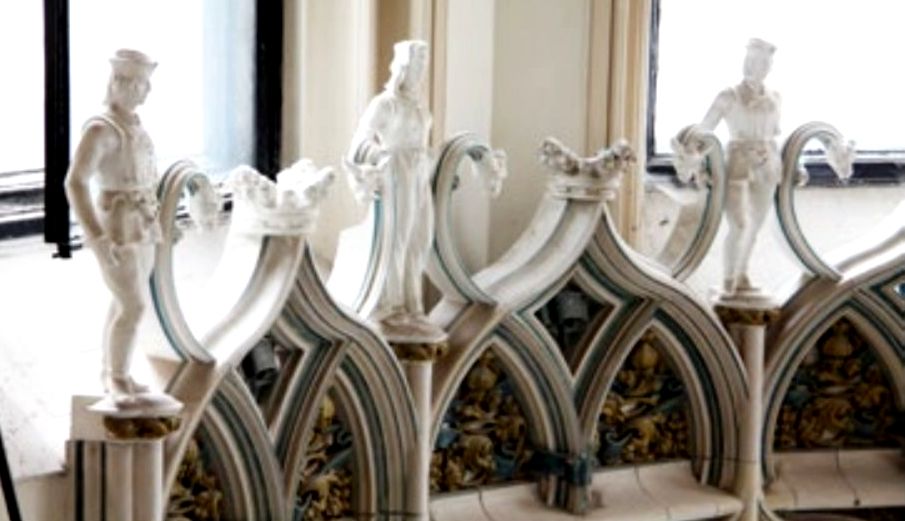
Pyrogranite statues of squires and noble ladies from the Zsolnay factory (Source: Júlia Katona: „Magyar érzést akartam kifejezni…” A Magyar Királyi Pénzügyminisztérium Szentháromság téri épületének ornamentikája, 2019)
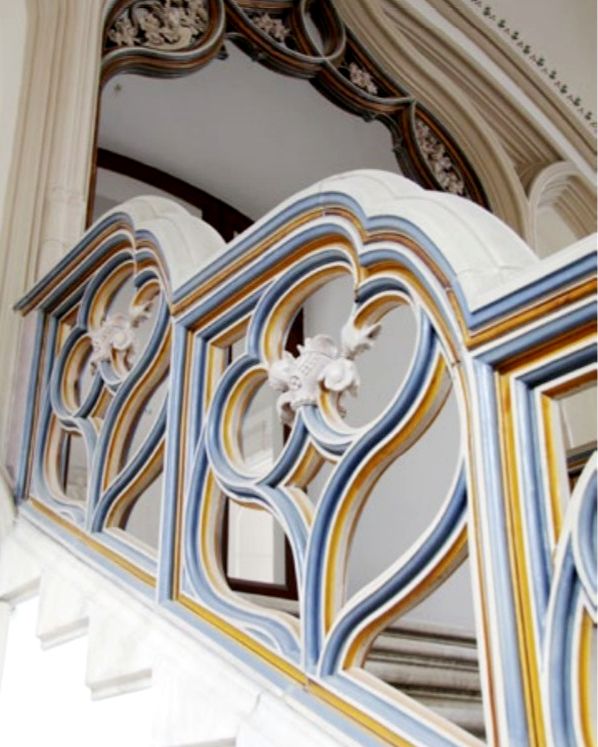
The railing of the grand staircase with Zsolnay ceramics
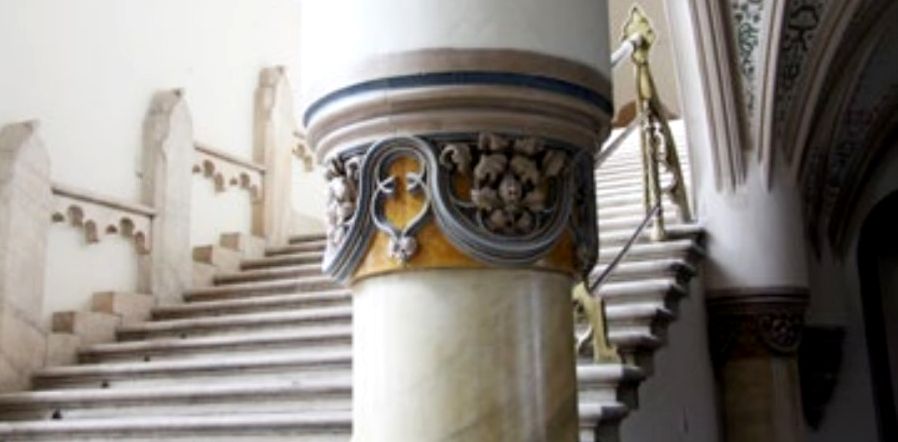
The Zsolnay ceramic column head of the grand staircase (Katona Júlia: „Magyar érzést akartam kifejezni…” A Magyar Királyi Pénzügyminisztérium Szentháromság téri épületének ornamentikája, 2019)
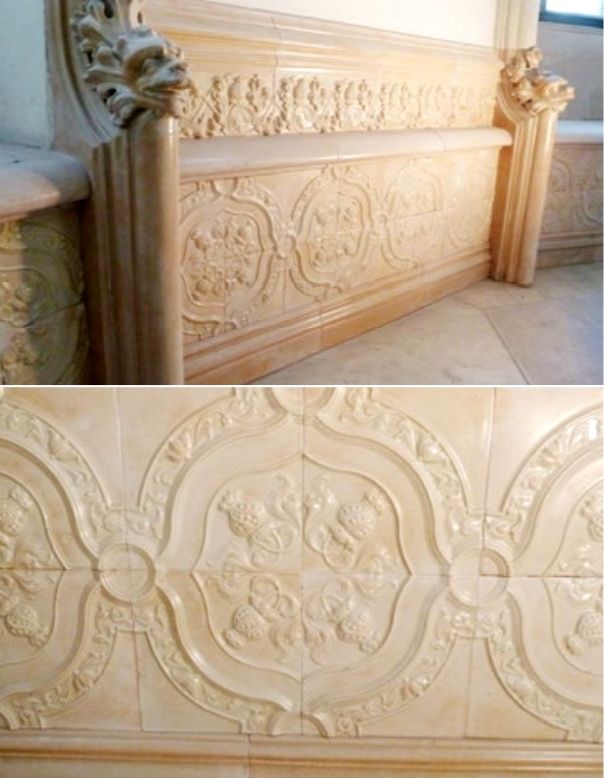
Zsolnay ceramic wall tiles in the grand staircase (Source: Katona Júlia: „Magyar érzést akartam kifejezni…” A Magyar Királyi Pénzügyminisztérium Szentháromság téri épületének ornamentikája, 2019)
A contract for flooring and carpentry work was signed with Gregersen and Sons. Gregersen was born in Norway in 1824. He arrived in Budapest in his twenties after his bags were stolen on his way to Munich. He heard about a construction project in Budapest and decided to earn enough money to continue his journey here. Eventually, he participated in the war of independence, invited several members of his family to from Noway, and built one of the largest enterprises in the country.
He worked as a carpenter on several major railway lines (Esztergom–Párkány, modern-day Štúrovo, Slovakia), rail bridges, tunnels and train stations (Keleti Pályaudvar in Budapest). His workshop operated in Lónyay Street in Ferencváros, and a plaque bears his name on the house in which he once lived. He was a contractor on several major construction sites: the Parliament Building, Matthias Church, The Museum of Fine Arts and Bakáts Square Church.
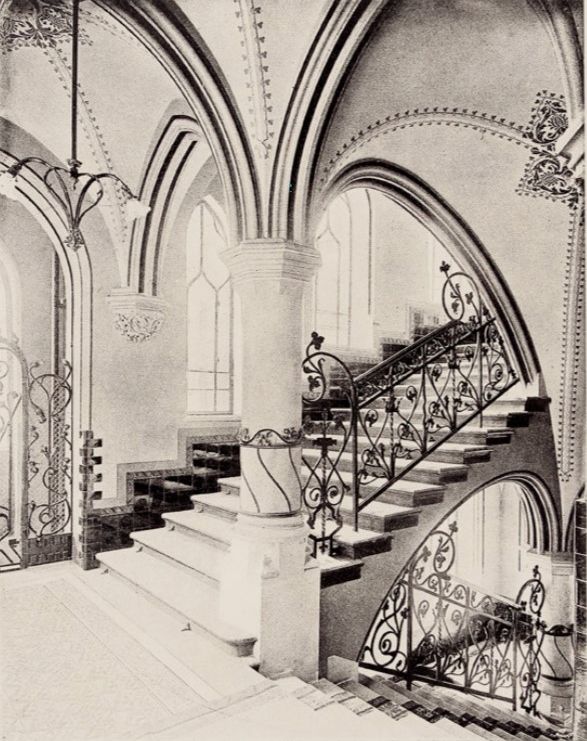
Ornate bannisters and decorative painting with Hungarian motifs (Source: Fellner Sándor: A Magyar Királyi Pénzügyministerium palotája, 1908)
He undertook the lion's share of the reconstruction efforts following the flood in Szeged and was created a noble for his efforts. He met his wife in Szob. The couple had 19 children. He learnt Hungarian with his family and believed that both Hungarian and Norwegian mentalities were important.
The Schlick Iron Foundry was commissioned to create the library staircase. Ignác Schlick was born in Pest in 1821. He studied in France and Switzerland and founded his factory in 1847 upon returning to Buda. He was the manager of the foundry in the Óbuda Shipyard for a time and then founded another venture with Frigyes Langenfeld. His work can b seen in several major buildings around Budapest. The stage and roof structure of the Opera, and the metal structures of the Main customs House, the Hungarian Academy of Sciences and the hall of Industry were all his work.
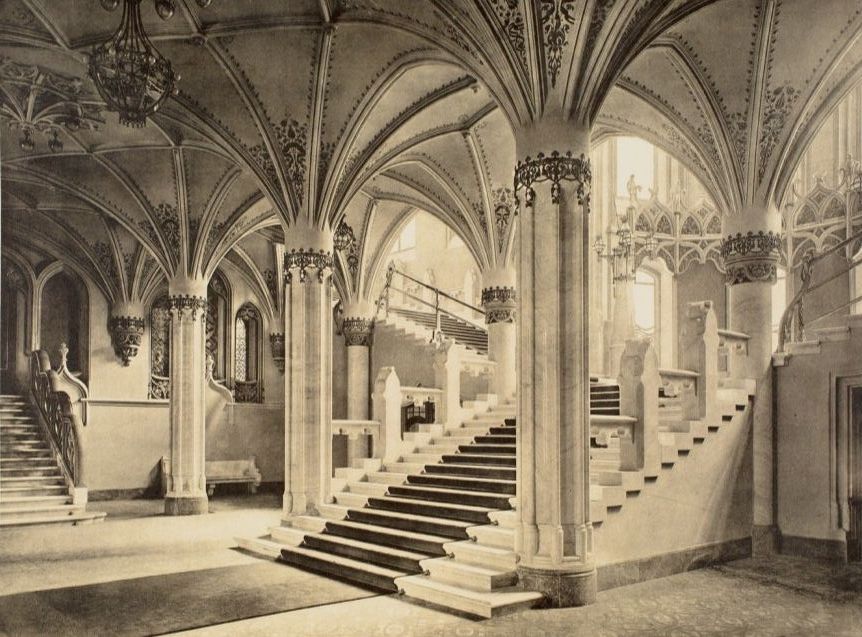
The grand staircase covered in a carpet made by Fülöp Haas' factory the Hungarian motifs of the wall painting also visible.
(Source: Sándor Fellner: A Magyar Királyi Pénzügyministerium palotája, 1908)
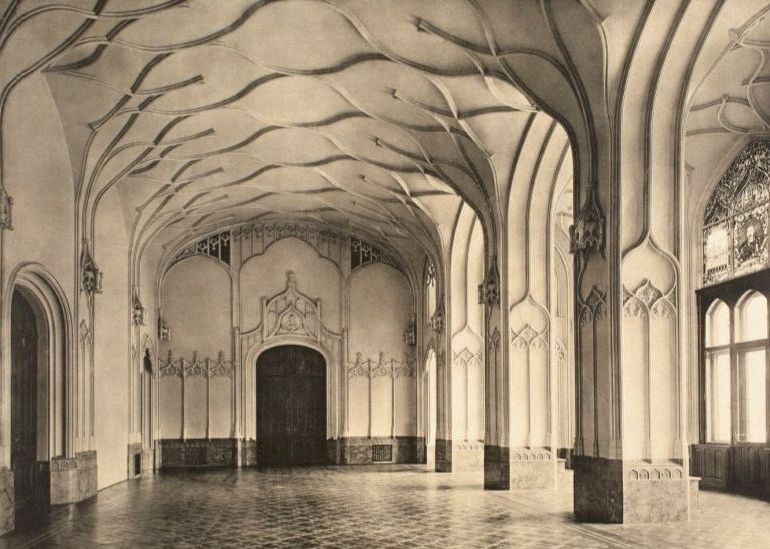
The vaulted ceiling of the main hall, and glass windows by Sándor Ligeti (Source: Sándor Fellner:
A Magyar Királyi Pénzügyministerium palotája, 1908)
József Hichmann was tasked with the wrought-iron working. Borin in 1870 he died tragically young, on 28 April 1912 aged only 42. During his short careers the works he completed rivalled those of his best-known fellow ironworkers: Gyula Jungfer, Sándor Árkay or Nándor Páder. His workshop was first in Rózsák Street, then on Rózsák Square. In the last years of his life, the factory he owned on Dongó Street employed 150 people.
His work on the Ministry of Finance can be seen as some of his earlier pieces, and he on the design tender against some of the most well-known names in the industry. Alongside the metal railings, he completed the three huge gates on the main facade, showcasing not only gothic characteristics but bringing art nouveau to life.
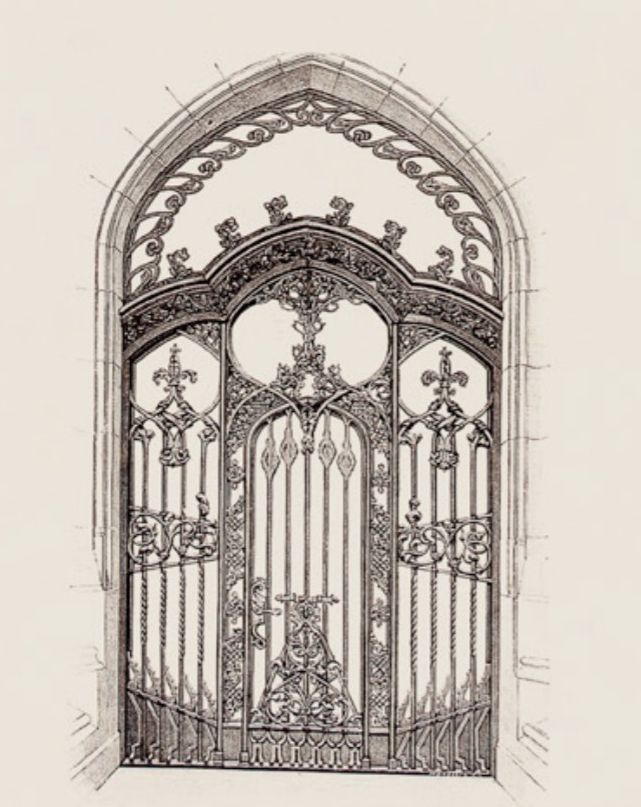
Ornate main gate by József Hochmann (Source? Sándor Fellner: A Magyar Királyi Pénzügyministerium palotája, 1908)
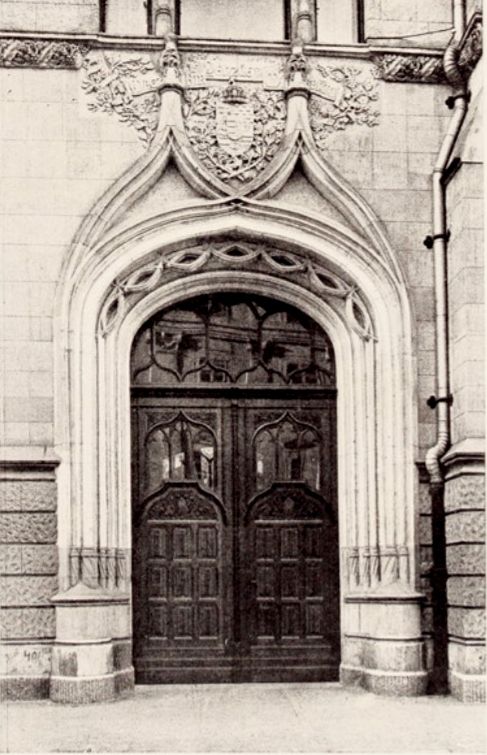
Ornate gate with coad of arms, on Fortuna street (Source: sándor Fellner: A Magyar Királyi Pénzügyministerium palotája, 1908)
Antal Zilzer and Sándor Ligeti created the painted glass windows, while Endre Thék and Miksa Schmidt supplied the furniture. Lajos Gönczy carved a statue of Franz Joseph, which was placed in the Minister's reception hall. Péter Melocco's workshop produced the floor coverings, while Fülöp Haas supplied the red carpet of the grand staircase.

A landing of the grand staircase with a rest stop and stained glass windows by Antal Zilzer
(Source: Sándor Fellner: A Magyar Királyi Pénzügyministerium palotája, 1908)
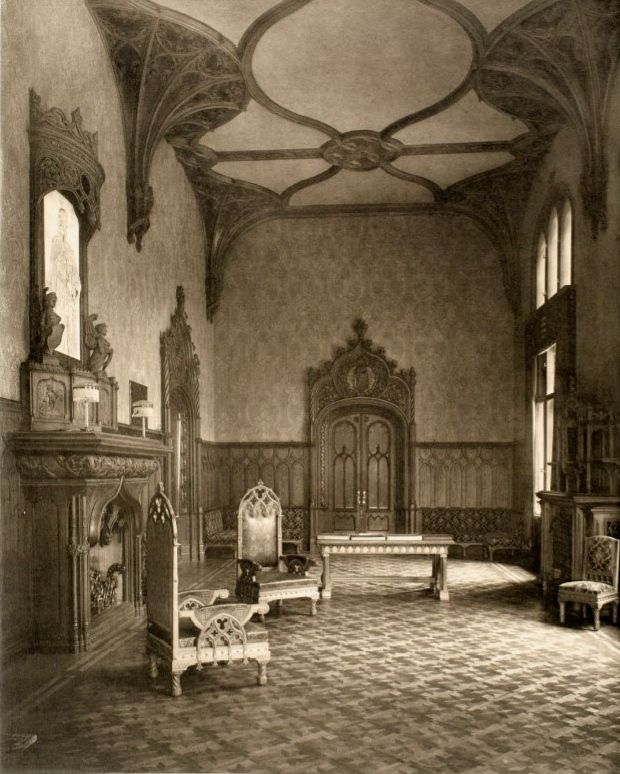
The Minister's Reception Hall is a masterpiece of applied art. The flooring was completed by the Gregersen company, the mantelpiece decorated with the carving of Franz Joseph by Lajos Gönczy (Source: Sándor Fellner: A Magyar Királyi Pénzügyministerium palotája, 1908)
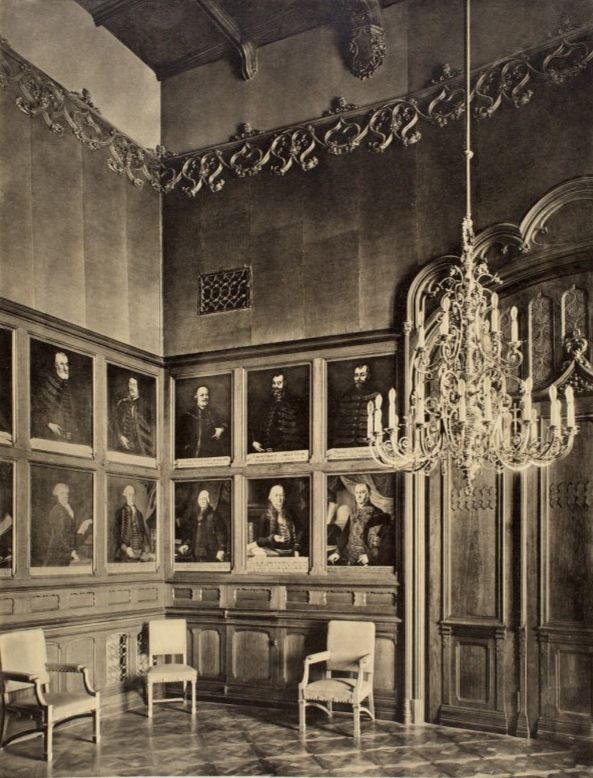
A chandelier from a Minister's waiting room. The best of Budapest worked on the project (Source: Sándor Fellner: A Magyar Királyi Pénzügyministerium palotája, 1908)
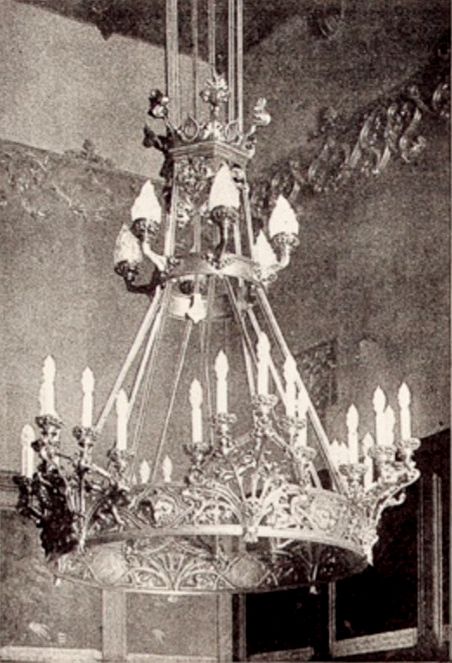
The work of these masters is admired to the present day (Source: Sándor Fellner: A Magyar Királyi Pénzügyministerium palotája 1908)
János Hein was responsible for landscaping the palace courtyard. He chose silver pine and birch alongside assorted flower beds and bordered these with boxwood. Hein was born in Hamburg in 1866 and travelled to Hungary in 1891, where he worked for a gardening company. In 1893 he founded a garden architecture office and then a tree nursery. By the time he died in 1935, he had designed and built about three hundred ornamental gardens. One of his designs was awarded a gold medal at the Paris World's Fair in 1900. Beyond the palace of the Ministry of Finance, he was responsible for the gardens of the Lukács Bath, the garden of the Park Club on Stefánia Road, and the gardens of the Clinics on Üllői Road and the Lipótmező Mental Hospital.
Sándor Fellner's efforts to present Hungarian motifs should also be highlighted. He wrote about the subject in the 1908 album:
"As I chose a Historical style as the base of the building, I aimed to give it Hungarian flavour. I wanted to give the lines, arches, ornaments and plant and geometric motifs some Hungarian flavour."
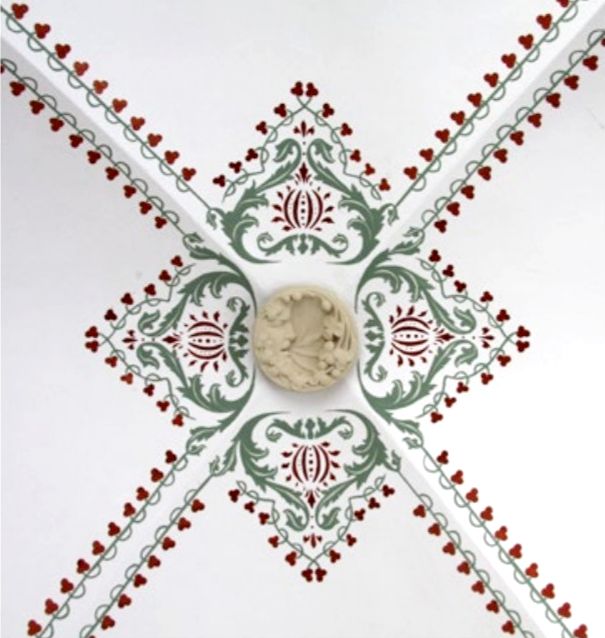
Painted vaulted ceiling of the staircase with pomegranate mofits (Source: Júlia Katona: „Magyar érzést akartam kifejezni…” A Magyar Királyi Pénzügyminisztérium Szentháromság téri épületének ornamentikája, 2019)
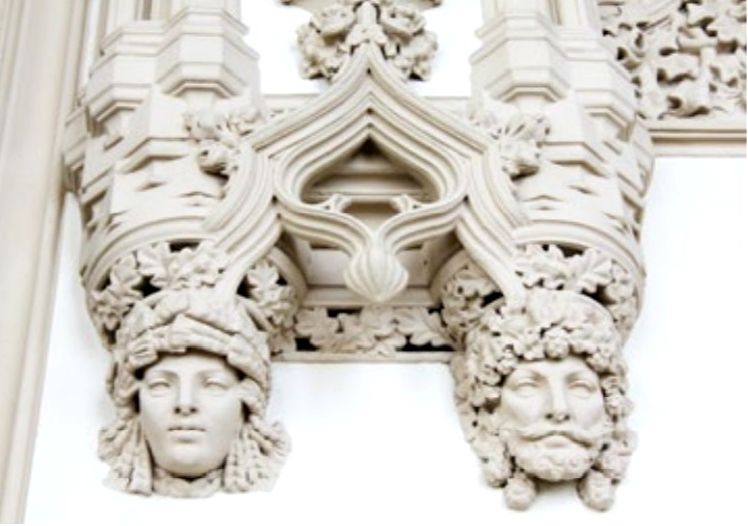
Oak and wheat patterns on the grand staircase (Source: Katona Júlia: „Magyar érzést akartam kifejezni…”
A Magyar Királyi Pénzügyminisztérium Szentháromság téri épületének ornamentikája, 2019)
Alongside the above-mentioned decorative pattern on the roof, the ten gargoyles on the exterior are also of note. These monster-headed statues borrowed from Gothic architecture were inspired by the bull-head-shaped drinking vessel of the Treasure of Nagyszentmiklós.
Peacock feather, pomegranate and tulip motifs decorate the internal painted walls. The consoles are decorated with wheat, grapes, oak leaves, and pine cones as symbols of abundance, prosperity, wealth, and the function of the building.
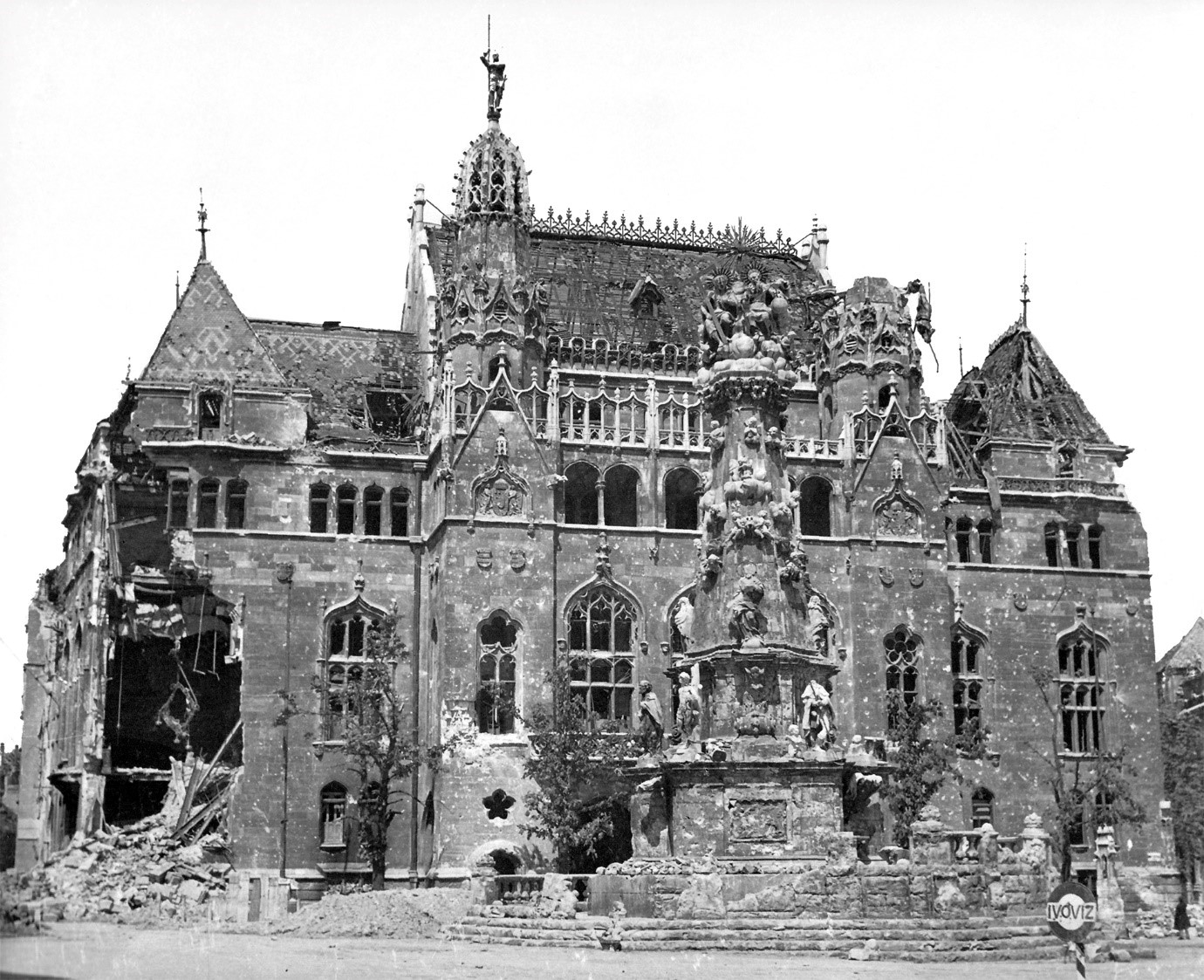
The main facade was damaged in 1945 (Photo: Budapest History Museum)
The building stood unaltered until the siege of the Castle District and then suffered serious damage. Following the perspective of rebuilding historic buildings at the time, the National Committee for Historic Monuments accepted a plan with a simplified facade by jenő Rados, for the reconstruction.
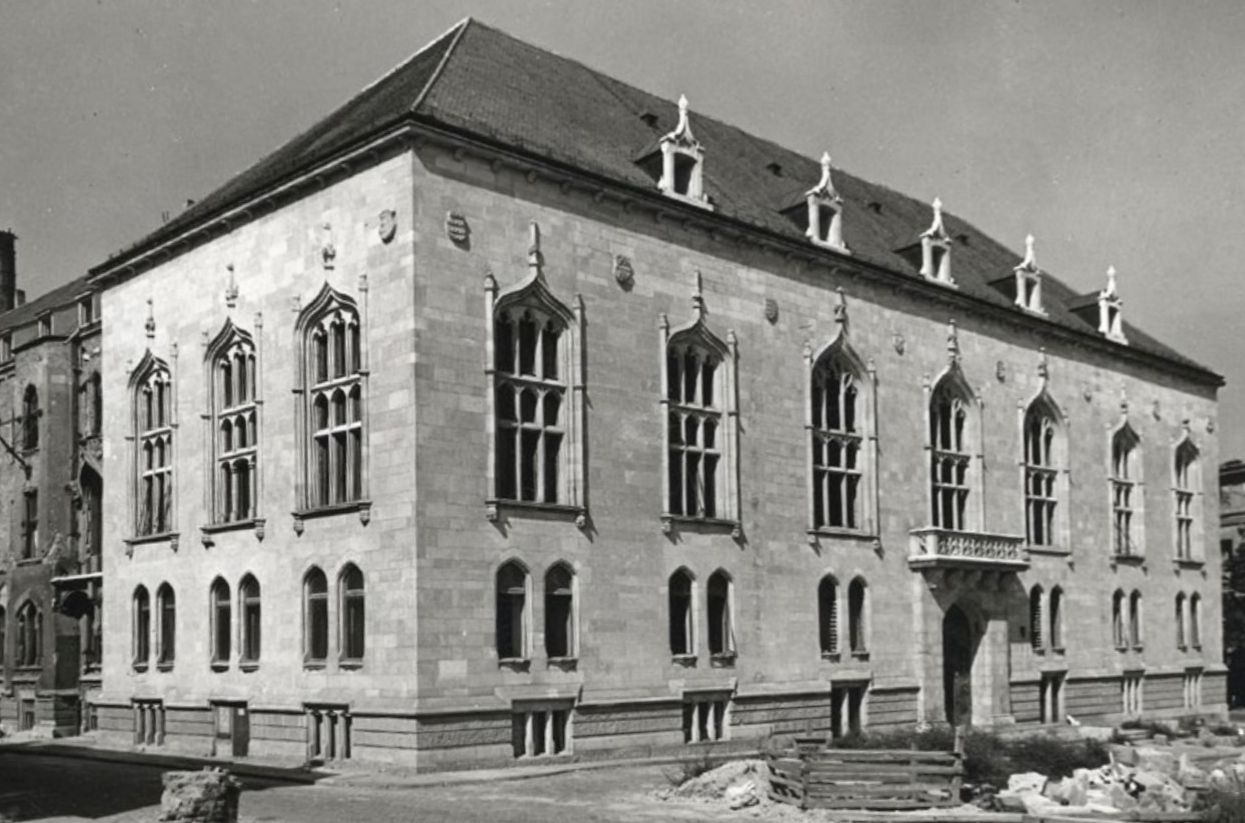
The "restored" building (Photo: Budapest History Museum)
The former building of the Royal Hungarian Ministry of Finance occupies a special place in the cityscape of the Castle District and all of Budapest. The artists who worked on this masterpiece created a unique balance of historicism, neo-Gothic architecture, art nouveau, and Hungarian motifs. Hopefully, the current restoration efforts will return the building to the spirit in which Sándor Fellner first created it.
Cover photo: Former building of the Ministry of Finance (Source: Sándor Fellner: A Magyar Királyi Pénzügyministerium palotája, 1908)

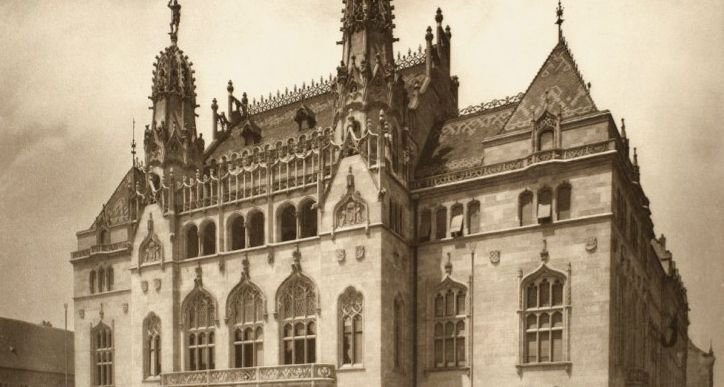



































Hozzászólások
Log in or register to comment!
Login Registration